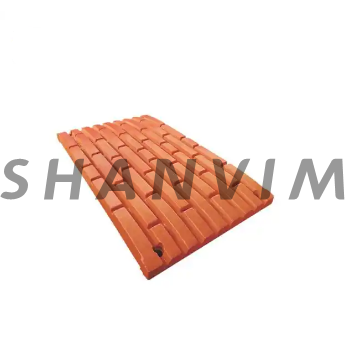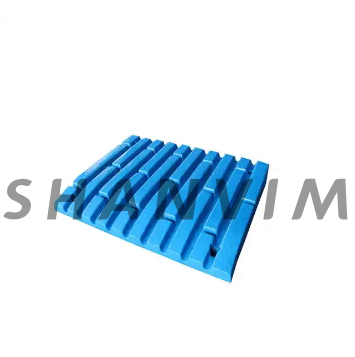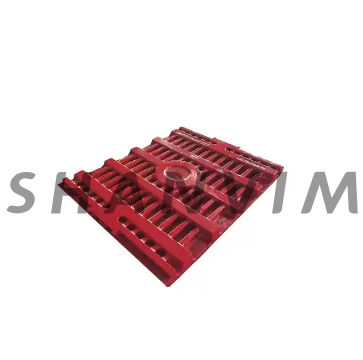The upper part of the movable jaw plate of the jaw crusher is connected with the eccentric shaft, the lower part is supported by the thrust plate, and the fixed jaw plate is fixed on the frame. When the eccentric shaft rotates, the movable jaw plate mainly bears the extrusion action of the material, while the fixed jaw plate mainly bears the sliding cutting action of the material. As a part with high wear rate of jaw crusher, the choice of jaw plate material is related to the cost and benefit of the user.
High manganese steel
High manganese steel is the traditional material of the jaw plate of the jaw crusher, which has a good ability to resist impact loads. However, due to the structure of the crusher, the opening angle between the movable and fixed jaws is too large, which is easy to cause the abrasive to slide. The degree of hardening is not enough, so the surface hardness of the jaw plate is low, and the abrasive material cuts in a short distance, and the jaw plate wears faster.
In order to improve the service life of the jaw plate, a variety of jaw plate materials have been developed, such as adding Cr, Mo, W, Ti, V, Nb and other elements to modify high manganese steel, and to carry out dispersion strengthening treatment on high manganese steel. Improve its initial hardness and yield strength. In addition, medium-manganese steel, low-alloy steel, high-chromium cast iron and high-manganese steel composites have also been developed, all of which have been well used in production.
Medium manganese steel
Medium manganese steel was invented by Climax Molybdenum Co., Ltd. and officially included in the US patent in 1963. The hardening mechanism is: when the amount of manganese is reduced, the stability of austenite decreases, and when it is impacted or worn, the austenite is prone to deformation and induces martensitic transformation, thereby improving its wear resistance. Common composition (%) of medium manganese steel: 0.7-1.2C, 6-9Mn, 0.5-0.8Si, 1-2Cr and other trace elements V, Ti, Nb, rare earth, etc. The actual service life of medium manganese steel jaw plate can be increased by more than 20% compared with high manganese steel, and the cost is equivalent to high manganese steel.
High chromium cast iron
Although high chromium cast iron has high wear resistance, but because of its poor toughness, using high chromium cast iron as jaw plate may not necessarily achieve good results. In recent years, high chromium cast iron has been used to inlay or bond high manganese steel jaws to form composite jaws. The relative wear resistance is as high as 3 times, and the service life of the jaws has been significantly improved. This is also an effective way to increase the service life of the jaw plate, but its manufacturing process is more complicated, so it is more difficult to manufacture.
Medium carbon low alloy cast steel
Medium-carbon low-alloy cast steel is also a widely used wear-resistant material. Due to its high hardness (≥45HRC) and appropriate toughness (≥15J/cm²), it can resist the cutting of materials and repeated extrusion. Fatigue spalling, thus exhibiting good wear resistance. At the same time, the medium-carbon low-alloy cast steel can also adjust the composition and heat treatment process to change the hardness and toughness in a wide range to meet the requirements of different working conditions. The production and operation test shows that the service life of the general medium-carbon low-alloy steel jaw plate can be more than 3 times longer than that of high-manganese steel.
Suggestions for jaw plate material selection
To sum up, ideally, the choice of jaw plate material should meet the requirements of high hardness and high toughness, but the toughness and hardness of the material are often contradictory. Therefore, in the actual selection of materials, it is necessary to understand the working conditions and choose reasonably. material.
Impact load is one of the important factors that should be considered in reasonable material selection.
The larger the specification, the heavier the wearing parts, the more lumpy the crushed material, and the greater the impact load it bears. At this time, modified or dispersion strengthened high manganese steel can still be used as the object of material selection.
For medium and small crushers, the impact load on the wearable parts is not very large, and it is difficult to work harden with high manganese steel. Under such working conditions, good technical and economic benefits can be obtained by choosing medium-carbon low-alloy steel or high-chromium cast iron/low-alloy steel composite material.
The composition and hardness of materials are also factors that cannot be ignored in reasonable material selection.
Generally speaking, the higher the hardness of the material, the higher the hardness requirements for the material of the wearable parts. Therefore, under the condition of meeting the toughness requirements, materials with high hardness should be selected as much as possible.
Reasonable material selection should also consider the wear mechanism of wearing parts.
If cutting wear is the main material, hardness should be considered first when selecting materials; if plastic wear or fatigue wear is the main material, plasticity and toughness should be considered first when selecting materials.
Of course, when selecting materials, the rationality of the process should also be considered, so that it is easy to organize production and quality control.
Shanvim as a global supplier of crusher wearing parts, we manufacture cone crusher wearing parts for different brands of crushers. We have more than 20 years of history in the field of CRUSHER WEAR PARTS. Since 2010, we have exported to America, Europe, Africa and other countries in the world.
Post time: Mar-16-2023




